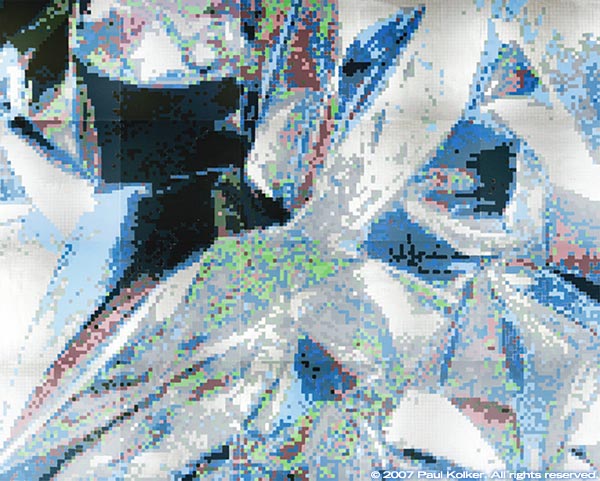
Stereopsis, also called binocular stereoscopic vision, is one of the ways we see three-dimensional objects and judge depth and distance. The other ways we see depth and judge distance, even in two-dimensional pictures of three-dimensional objects, is by trompe l’oeil or “tricking the eye” with perspective, occlusion, parallax, rotation, size relativity, contrast, luminosity and darkness, shadow-casting, focus and color effects. Still another “trick”, the depiction of geometric forms, spaces and surfaces, the shapes of which suggest depth, is called neocubism by Kolker because of its relationship to the “new” mathematics of fractal geometry, the basis for computer 3-D modeling programs producing graphs with expansive depth and dimensional effects.
Kolker’s art experiment was triggered by the accidental but astonishing stereoscopic effects in his knots and dots series of paintings. In a procedure based style of painting which Kolker calls fracolor, he uses digital photography and fractal computer programs to fractionate the subject image into a map by which he paints. His palette is founded in light optical and pigment color theories from which he has selected red, blue, green and yellow plus the anachromics black and white. He creates shades and tints by mixing color with black and white, while eschewing mixing colors with each other. The resultant painting is silkscreened, creating a grid of colored dots, like the static frame of pixels on our computer or television screen.
Following a review of published works of others, Kolker studied his paintings which exhibited the most remarkable stereoscopic effects. The paintings were large scale and appeared different close up and from afar. The foregrounds were luminous and the fargrounds were dark. Intersecting and overlying planes created occlusion, rotation, perspective and parallax. All had painted colored dots circumscribed by a black grid.
Could perception of depth be related to the grid of colored dots? Stereoscopic vision is tested using grids of dots, seen differently in each eye and reconstructed in the brain with virtual depth. Could the large scale painting with thousands of dots result in vision field “overload” with thousands of things to see at once, resulting in a myriad of movements of both eyes, called microsaccades? Could each retinal image be somewhat different because of the rapid eye movements and when reconstructed in the brain, give the perception of depth? Or, could it be that each eye sees thousands of colored dots differently and the effect is like wearing glasses with a red lens over one eye and a blue or green over the other? Or, is it all about classical perspective seemingly vanishing into a point or dot?
A sheet of aluminum foil was crumbled into a ball, reopened like a topographic map of our planet and photographed on a copy stand. Lighting effects, color screens and a black foamcore board above the camera created foreground brightness, color and a dark field in the farground. A “cubism-like” image was selected for computer redaction, painting and silkscreening in different ways so that the measuring instrument, the viewer, could compare and contrast perceived effects. Similarly treated images of impasto and amorphous forms served as controls.
Fifteen paintings address and test the experimental design conditions including the questions raised regarding the scope and scale of the image field, the effects of colored dots or squares and classical perspective. In surfaces, a large-scale 96 × 240 inch painting based on a reconstructed wrap-around photograph of a familiar high-ceilinged warehouse superstore, you may see a new dimension beyond panorama…experience the stereopsis of neocubism in a two-dimensional painting…and, perhaps, formulate your perception of the conclusion to Kolker’s experiment!
Paul Kolker: forms, spaces and surfaces — Opening October 18, 2007.
